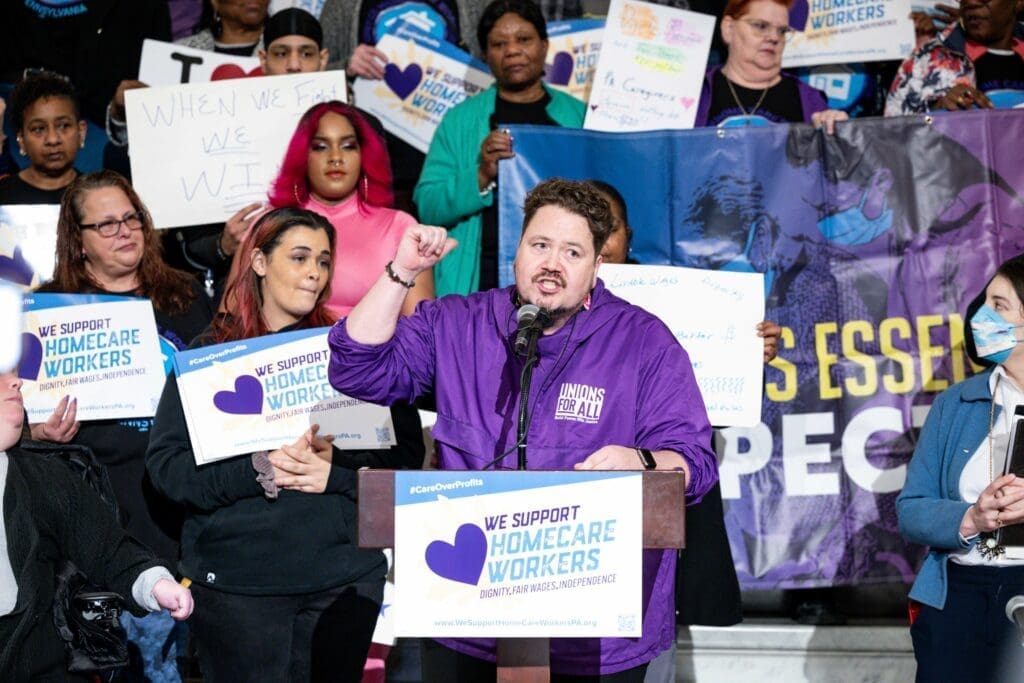Pennsylvania has a home care worker shortage. Higher wages could help.
Rep. Jessica Benham’s legislation would boost wages and benefits for workers and better regulate private equity.

By the time Easter ended, Linda Orndoff was exhausted.
She had spent the day as she does every day of the week: being an at-home caregiver for her 89-year-old mother with dementia and her grandson who’s on the autism spectrum. For about 10 hours a day, seven days a week, the Coal Center resident cooks, cleans and makes sure her family members’ needs are met.
In order to care for her aging mother and her grandson, Orndoff quit a full-time job and in 2018 became what’s known as a paid participant-directed home care attendant, for which she receives about $13 an hour from Pennsylvania’s Medicaid program that’s funded by state and federal dollars. She receives no health insurance, paid time off or any other benefits.
That $13 an hour is better than nothing, but it’s not a livable wage and doesn’t come close to adequately compensating her for the long days that are often isolating and physically and mentally depleting, Orndoff explained. She finds it incredibly depressing when she considers that she was making a little less than $13 an hour at her job in 1980. Previously, she worked in quality assurance in barge building.
“Yesterday, that was a holiday [Easter] for everybody else, but it was an extremely tiring day for me,” Orndoff told the Pennsylvania Independent on Monday. “I was exhausted by the time last night rolled around, and I never get a break or anything. If we had a sustainable home care system, caregivers would be able to take a day off occasionally to take care of their own needs.”
Still, there’s a reason Orndoff has given up so much to be by her mother’s and grandson’s sides: She wants to ensure they can remain in their home, surrounded by people who love them. Neither her mother nor her grandson want to go to a separate living facility such as a nursing home.
“[My mother] and my stepfather bought this property somewhere around 40, 45 years ago,” Orndoff said of the home in which she cares for her family. “So, for the last, say, 40 years of her life, this is the only place she’s known.”
“She’s got a kitty cat in her house that she dearly loves, and to take her away from her kitty cat and everything she’s known and loved her whole life would just be devastating,” Orndoff continued. “I don’t think she would last.”
As Pennsylvania’s population ages, following a nationwide trend, there’s a growing number of older residents who, like Orndoff’s mother, need or will need some form of home care, whether that’s from a family member or a home care agency. But with home care jobs providing low wages and often no or few benefits, the field has a shortage of workers and high turnover rates.
Right now, Pennsylvania needs approximately six times the number of home care workers that are currently working in the state to meet the existing demand — and that shortage will grow even further as the number of older residents increases, said Matthew Yarnell, president of SEIU Healthcare PA, a union that represents home care workers and other health care workers. There are about 100,000 home care workers in the commonwealth now.

To address what Yarnell and Orndoff call a home care crisis, Democratic state Rep. Jessica Benham is currently crafting legislation that aims to increase home care workers’ wages and benefits, as well as better regulate the home care agency industry — particularly when it comes to private equity’s takeover of a large chunk of the field. Four of the state’s largest home care agencies, for example, are owned by private equity firms, according to a 2023 analysis of state data by SEIU Healthcare PA.
“We know that in every industry that private equity plays a part that we start to see a disinvestment in workforce or in product and that those cost savings are passed on as profits to shareholders,” Benham told the Pennsylvania Independent.
Benham, who announced her bill at a press conference in March, said the legislation would increase state funding for home care workers in order to boost wages; require a market-based analysis of rates every three years; mandate that at least 80% of the funding that home care agencies receive from the state is spent on worker compensation; and create a higher state reimbursement rate for home care agencies that invest at least 90% of their state funding in their workforce.
Either home care workers receive their hourly pay directly from the state, as Orndoff does, or workers at home care agencies are paid by employers who receive funding through the state’s Medicaid program. The state currently provides a $20.63 average hourly reimbursement rate for home care agencies, though an average of only about two-thirds of that is going to wages. Home care workers earn an average of $13 an hour in the commonwealth.
“There’s nobody who can live in this economy at $13 an hour,” Yarnell said. “And at the same time, the average agency home care rate in Pennsylvania is $20 an hour. So we believe it’s time to really tackle the significant amount of money that’s pouring into this system that is not reaching caregivers.”
Benham said her legislation, which she’s co-sponsoring with Republican Rep. Jason Ortitay and which has yet to be introduced, is meant to serve as a wake-up call to lawmakers who have put home care on the back burner for years.
“The truth is that this is not a small dollar amount that we’re talking about if we’re really going to get serious about investing in home care workers,” Benham said, noting that the specific dollar amount in the legislation has yet to be determined. “But the flip side of that is that if we don’t invest, it’s worse.”
Why lawmakers haven’t prioritized funding home care is, at least in part, rooted in sexism, Yarnell said. Women make up 87% of the country’s home health aides, 90% of nursing assistants and 80% of personal care aides, according to the Bureau of Labor Statistics.
“I think it’s driven by the fact that it’s largely women who do this work, and I think it’s largely viewed as kind of glorified babysitting, which I think are all wrong,” Yarnell said. “And I think that if we had a robust system, I think we would have a healthier commonwealth and certainly healthier outcomes for care recipients.”




